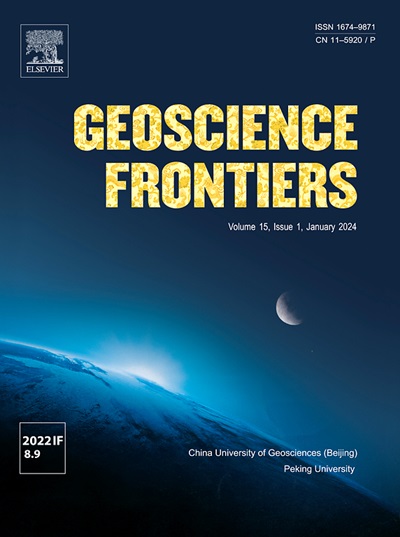Characteristics and drivers of carbonaceous aerosol pollution in a coastal city of northern China
IF 8.9
1区 地球科学
Q1 GEOSCIENCES, MULTIDISCIPLINARY
引用次数: 0
Abstract
Carbonaceous aerosols significantly impact air quality, human health and climate change, yet their concentration levels and influencing factors exhibit significant regional variability. This study examined the concentration levels and temporal variations of carbonaceous aerosols in Qingdao, a typical coastal city in China, using a year-long, high-time-resolution dataset of organic carbon (OC) and elemental carbon (EC) measurements. The impacts of meteorological conditions, primary emissions, atmospheric oxidants, and sea-land breezes were systematically analyzed by employing an interpretable machine learning model. The results revealed that atmospheric OC and EC concentration levels were relatively low in Qingdao, but secondary organic carbon (SOC) accounted for 43 % of OC, emphasizing the substantial influence of secondary sources. SOC concentrations peaked in the evening, whereas primary organic carbon (POC) and EC concentrations peaked during morning rush hours. The elevated carbonaceous aerosol concentration observed in winter likely resulted from enhanced primary emissions coupled with unfavorable dispersion conditions, whereas intensive photochemical activities during summer facilitated SOC formation. Higher SOC levels were observed during sea-land breeze days than non-sea-land breeze days. The machine learning model indicated that atmospheric oxidants played an important role in SOC formation during sea-land breeze days, while combustion related emissions may be the key factor on non-sea-land breeze days. Furthermore, SOC levels were higher under land breezes compared to sea breezes, likely due to enhanced primary emissions from terrestrial sources coupled with confined pollutant dispersion. These findings revealed complex emission-meteorology-chemistry interactions affecting coastal air quality, informing targeted air pollution mitigation strategies.

中国北方沿海城市碳质气溶胶污染特征及其驱动因素
碳质气溶胶显著影响空气质量、人类健康和气候变化,但其浓度水平和影响因子表现出显著的区域差异。本研究利用为期一年的高时间分辨率有机碳(OC)和元素碳(EC)测量数据,研究了中国典型沿海城市青岛含碳气溶胶的浓度水平和时间变化。通过采用可解释的机器学习模型,系统地分析了气象条件、一次排放、大气氧化剂和海风的影响。结果表明,青岛市大气OC和EC浓度水平相对较低,但二次有机碳(SOC)占OC的43%,表明二次源对OC的影响较大。有机碳(SOC)浓度在傍晚达到峰值,而原生有机碳(POC)和有机碳(EC)浓度在早高峰时段达到峰值。冬季观测到的碳质气溶胶浓度升高可能是由于一次排放增加加上不利的扩散条件,而夏季强烈的光化学活动促进了有机碳的形成。海陆风日土壤有机碳含量高于非海陆风日。机器学习模型表明,大气氧化剂在海陆风日对有机碳形成起重要作用,而燃烧相关排放可能是非海陆风日的关键因素。此外,与海风相比,陆风下的有机碳水平更高,这可能是由于陆地源的一次排放增加,加上污染物扩散受限。这些发现揭示了影响沿海空气质量的复杂的排放-气象-化学相互作用,为有针对性的空气污染缓解策略提供了信息。
本文章由计算机程序翻译,如有差异,请以英文原文为准。
求助全文
约1分钟内获得全文
求助全文
来源期刊

Geoscience frontiers
Earth and Planetary Sciences-General Earth and Planetary Sciences
CiteScore
17.80
自引率
3.40%
发文量
147
审稿时长
35 days
期刊介绍:
Geoscience Frontiers (GSF) is the Journal of China University of Geosciences (Beijing) and Peking University. It publishes peer-reviewed research articles and reviews in interdisciplinary fields of Earth and Planetary Sciences. GSF covers various research areas including petrology and geochemistry, lithospheric architecture and mantle dynamics, global tectonics, economic geology and fuel exploration, geophysics, stratigraphy and paleontology, environmental and engineering geology, astrogeology, and the nexus of resources-energy-emissions-climate under Sustainable Development Goals. The journal aims to bridge innovative, provocative, and challenging concepts and models in these fields, providing insights on correlations and evolution.
 求助内容:
求助内容: 应助结果提醒方式:
应助结果提醒方式:


